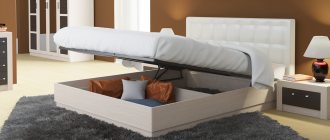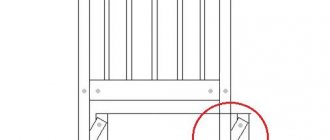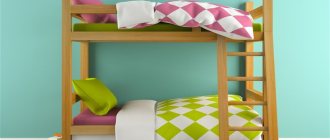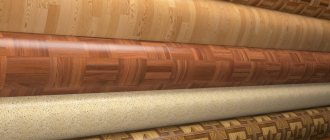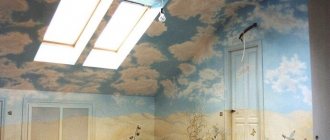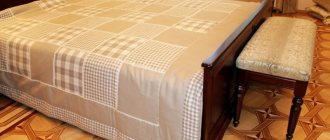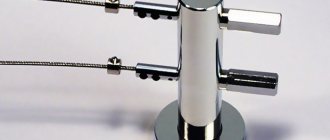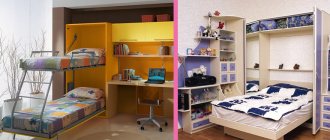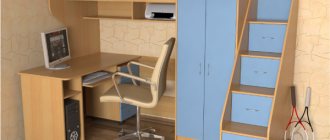Principle of operation
All modern beds with a lifting function work on a similar principle - moving the base, lifting it to a certain angle and maintaining the position using both muscle force and special clamps.
The design of most mechanisms is approximately the same: there are two metal plates, upper and lower, which are attached to the base and side of the laundry box, respectively. The connection of these plates is carried out using a special rod (or rods - there may be several of them), the location of which forms an opening arc.
The operating principle of all beds is approximately the same.
Important! In most cases, such a mechanism is equipped with a force compensator to make the base easier to lift, but in the cheapest options it is usually absent.
Types and varieties
Today, many multifunctional beds can have a built-in mechanism made according to one of three common design schemes:
Manual lift hinges
This design involves lifting solely through muscular strength. Considering that there will be a mattress, a blanket and, often, pillows on the base, then significant effort will be required. This solution assumes the presence of only a ratchet, which allows you to fix the opening angle - no springs or shock absorbers are provided here.
A bed with a manual mechanism will require considerable effort to lift.
Mechanism with spring compensator
This option is structurally similar to a manual mechanism. The key difference here is the presence of a compensating spring, which is in working condition (stretched) when the substrate is lowered. During the lifting process, the spring begins to compress, which partly reduces the degree of force applied.
In a spring mechanism, part of the load is carried by the spring.
Gas lift
This is what professional jargon calls a gas shock absorber, which is installed to relieve some of the effort when lifting the base, and also as an extreme position lock. Unlike the previous case, this solution allows you to easily and smoothly transform the bed.
With the help of a gas lift, the bed rises easily and smoothly.
Beds with a lifting mechanism: advantages and disadvantages
Most of the advantages of lift-top beds can be attributed to any type of opening mechanism. Therefore, it makes sense to highlight the positive aspects common to all designs:
- Compactness. Bed linens, blankets, pillows and clothes are stored under the bed, freeing up space elsewhere.
- Low noise level.
- Easy to use.
- Reliability. Especially in solutions where gas lift is used.
- Wide range of bed frames. You can choose a bed with a lifting mechanism to suit every taste and budget.
- Easy to maintain.
Lift beds have many advantages.
There are also disadvantages, which are typical for all options:
- Small gap between the bottom and the floor surface. When dust accumulates under the bed, removing it from there is a rather labor-intensive task without rearranging it.
- Lack of mobility. Due to its dimensions, such furniture can be placed in one place for a long time.
- Sagging. Cheap foundations begin to weaken over time, which affects the use of the structure as a whole.
The design also has its drawbacks.
Moreover, each version of the lifting mechanism has its own pros and cons.
Manual
The advantages include simplicity of design, reliability and ease of maintenance. As for the disadvantages, there is only one, but a significant one - the applied force required to lift the base.
The manual mechanism is the simplest and most reliable.
Spring
The advantage of this solution is the presence of a compensating effect, which allows you to remove part of the load (muscle force) during operation of the mechanism. The negative side will be the need to periodically replace the springs (over time they lose their original stiffness and stretch), as well as the complexity of installation, adjustment of the compression force and increased noise levels.
The springs will need to be changed periodically.
Gas bed lift mechanism
The advantage of gas shock absorbers is smooth operation during operation, lack of noise, unpretentiousness and durability. Among the disadvantages, it is worth mentioning the short stroke, reduced efficiency at low temperatures, and the impossibility of repairing at home.
Gas lift has both pros and cons.
Why an array?
A wooden bed is not a tribute to fashion or blindly following the trends of the modern furniture industry. The solid wood used in the production of this piece of furniture gives the future product unique characteristics. Thus, the wood from which the bed with a lifting mechanism is made has one of the lowest thermal conductivity coefficients, which means that every time you touch the bed, you will feel warm. In addition, a bed with a lifting mechanism, made of natural wood, is, of course, besides forged, the most environmentally friendly bed that you can imagine in the bedroom. And unlike wrought-iron furniture, a bed with a lifting mechanism made of pine, beech or oak creates an ideally comfortable atmosphere in an apartment or house, and due to its safety from injuries, it is especially useful for arranging a children’s room or a bedroom for the elderly. At the same time, the lifting bed remains the most functional piece of furniture.
How to choose a good mechanism?
When planning to purchase a bed with a lift-up top, in addition to other selection criteria, you should also pay attention to the installed lifting mechanism. It is recommended to consider the following:
- Compression force. Determines the force required to raise or lower the base, along with the mattress and bedding.
- Number of compensators. Typically, mechanisms using springs or gas shock absorbers are installed on both sides of the box. This allows you to reduce the applied force at the moment of opening and reduce the requirements for spring or gas lift power.
- Opening angle. Most often, this parameter directly depends on the capabilities of the compensating element.
- Workmanship. The ease of use and longevity of the mechanism directly depend on the reliability of the fastenings. Therefore, it is advisable to reject options using cheap designs. It is better to give preference to German or Italian manufacturers.
The choice of mechanism is carried out according to certain criteria.
Important! Typically, the power of the compensator is indicated in Newtons (N), while for springs it is determined by its stiffness, and for gas lift - by the pressure in the cylinder. For a single bed, this value starts at 300N, however, depending on the design, it can reach 2kN.
The power of the compensator may differ for different models.
Pros and cons of beds with a lifting mechanism
After selecting the base type, the buyer can select additional options. One of them is the installation of a lifting mechanism.
Many bed models can be equipped with a base with a lifting mechanism at the buyer's request. This is an orthopedic grille, in the upper part of which, at the head, there is a mechanism for gas elevators. Thanks to this, the base along with the mattress can be raised, and storage space appears under the bed.
What is gas lift? These are several cylinders filled with inert gas and a piston. With a little human effort, the gas moves the piston and raises the bed.
Even a child can lift a bed with a lifting mechanism, because the bed rises not due to the physical efforts of a person, but due to the energy of the expanding gas.
Advantages of a lifting base
By choosing a bed with a lifting base, the user receives:
- Convenient storage space. The top of the bed reclines quickly, silently and without much physical effort. Most often, the space under the bed is used to store bedding, sleep accessories or seasonal clothing. Things stored under the bed are protected from impacts and falls, so you can store the most fragile items, even dishes, there.
- Solving the problem of lack of free space in the bedroom. You don’t have to put a closet to store things, but put them under the bed. This is probably the main advantage of such beds.
- Cleaning the space under the bed can become much easier - just remove things and wipe the dust with a cloth or use a vacuum cleaner.
- Unlike roll-out drawers, a lift-up base does not require additional space in front of the bed to be used. It is enough to simply lift it using gas elevators.
- Reliability. The gas lift is designed for several thousand ascents and lowerings; it will serve for many years without breakdowns.
The amount of available space under the base may vary depending on the model.
Flaws
- When a sleeping area is shared by two partners, access to things under the base can become problematic.
- The storage space is located near the floor and under the mattress, so dust can collect inside the box. It is better to store things in boxes.
- The price of beds with a lifting mechanism is higher than the price of conventional models.
When folded, the lifting mechanism is invisible.
The most reliable components included in a bed with a lifting mechanism are strong slats at the base and a gas lift.
All models use gas lift - it is more reliable than standard spring designs, operates more smoothly and is designed for a long service life.
You need to pay extra for the lifting mechanism. But the expenses are justified - there is one more storage space in the room, you can refuse to buy a closet and not clutter the apartment with too much furniture.
Go to the full catalog of Bases with a lifting mechanism
0 item(s)
Compare Ormatek metal bed base with p/m
8 360 ₽
0 item(s)
Compare DreamLine box with laminated chipboard lifting mechanism
12 609 ₽
Reviews (1)
0 item(s)
Compare DreamLine box with solid wood lifting mechanism
20 239 ₽
Reviews (1)
0 item(s)
Compare Ormatek solid non-elastic base with PM
13 770 ₽
DIY mechanism: what is needed for this?
The simplicity of the basic design suggests that such a mechanism can be made by yourself. This is partly true, but only if you have experience working with metal, a drilling machine and a welding machine.
You can also make a structure with a lifting mechanism yourself.
If we talk about manufacturing in the context of general operating principles, we can highlight several key points:
- Drawing. Design features such as the width of the support plate flange, the length of the rods and the distance between the holes are calculated depending on the point of application of the load, its nature (point or distributed), as well as the position of the axis relative to the center of mass of the entire structure. If such calculations are difficult to do on your own, it is recommended to look for the most suitable ready-made solution.
- Construction type. The manual version is the simplest from a production point of view. However, if you want to install a compensator, the choice here is obvious - a gas shock absorber. Installing a spring requires an accurate calculation of its stiffness: a weak one will not hold the base, but a too stiff one will require significant effort when opening. In addition, it may simply not be in the store.
- Nature of use (intensity). This will determine how powerful (reliable) the mechanism is needed.
DIY “floating” bed
Hello, dear readers and DIYers! In this article, the author of the YouTube channel “HomeMadeModern” will tell you about a method for making a rather unusual “floating” bed, without magnets or any magic. Welding and a little carpentry - that's the trick!
Materials. — Untreated white cedar board — Angle steel, profile pipe 25X25 mm, strip 75X6 mm, mesh — Plexiglas plate — Abrasive polishing paste — Bolts, washers, nuts — Machine oil, aerosol primer for metal, enamel, linseed oil. Tools used by the author. — Multifunctional construction metal detector — Spring clamps, clamps — Chameleon welding helmet — Semi-automatic welding machine — Magnetic welder’s angle — Circular saw — Grinder, diamond cutting disc for metal — Abrasive “coral” cleaning disk — Orbital sander — Screwdriver, cobalt drills — Polishing wheel for a screwdriver - Hand-held circular saw - Swenson's square, tape measure, marker. Manufacturing process. The headboard will be made from a wide slab of white cedar, so the edge of the headboard will have a natural edge. By the way, this piece of wood is worth a lot...
The bed frame itself will be made of steel profile pipe 25X25 mm.
The latter is measured in length, the grinder is cut into sections. Only two tools are involved in the manufacture of the frame - an angle grinder and a welding machine.
Then all the elements are laid out in this order on the floor. In this case, in the middle, the long sections protrude slightly beyond the lines of the frame (about 2.5-3 inches). These protrusions are necessary so that the frame is slightly spaced from the wall so that the slab headband can be installed.
During welding work, the master uses a magnetic corner. The latter allow you to hold steel parts at a perfectly precise angle.
During the welding process, long crossbars may become slightly skewed. To prevent this from happening, the author recommends using a long clamp.
Instructions for making a similar clamp were given in a recent article.
Now we have to weld a couple of vertical posts that will hide behind the slab and fit right under the wall. In these areas, it is necessary to properly clean the welds until a smooth surface is obtained.
After this, the following cuts are made in the vertical segments.
Then the craftsman presses the steel strip with clamps to the vertical posts and welds it.
Next, in addition to the two legs that will be hidden behind the slab, the author plans to install another wide central leg made of plexiglass. It will give the entire structure reliability and stability.
To attach a transparent plexiglass plate to a steel frame, the craftsman cuts out a 50X50 mm piece from a steel corner and welds it to the center of the bed frame.
Next, he drills several holes in it through which the plexiglass plate will be attached to the base.
Although this part of the bed will be hidden from view, the author still intends to close the gaping holes in the profile at its ends. To do this, he cuts out several squares from scraps of profile pipe, fixes them with a magnetic corner and welds them around the perimeter. All seams are processed with a sanding disc.
The author wants to more securely attach the bed to the wall; to do this, use a metal detector to determine the location of the profile behind the drywall.
This is a very simple model; I would recommend this multifunctional construction metal detector.
After which the entire structure is screwed to the wall. The author tests how much the frame will bend and comes to the conclusion that the frame should be strengthened a little more.
So, several more bulkheads are welded onto the frame.
Now an expanded steel mesh is spread over the frame. It will also add rigidity to the structure. Excess parts of the mesh are cut off with a grinder. The mesh is fixed to the frame with a section of profile and two clamps, after which a painstaking welding process takes place.
Now the entire structure is covered with a layer of aerosol primer for metal.
Then the joints and recesses are rubbed with putty and sanded after drying.
The frame is covered with two more layers of white spray gloss enamel.
Next, on a circular saw, a plexiglass plate is cut to size using a disk with fine teeth. All its edges are carefully polished, starting from 150 to 220 grit.
Before processing all the cuts with 320 abrasive paper, the author drills holes in the slab, using a piece of plywood with prepared holes as a guide.
After removing the protective film, he further processes these surfaces.
However, you can achieve maximum transparency of thick plexiglass in another way, namely, using a gas burner or a technical hair dryer.
The time has come to install the wide leg. The two corners of the plexiglass had to be ground down a little so that the plate attached to the welding seam could be pressed as tightly as possible against the steel corner.
Additionally, the master applies a layer of silicone sealant in the gap between the corner and the slab to create a kind of pad that softens the rigid connection of the softer plastic with the hard article.
Next, the bolts and nuts are screwed in.
Now it’s the turn of the headboard. Excess wood is cut off.
The slab itself is processed with a grinding disc; the author takes special care to round off the corners and side edges. After this, the wood is additionally sanded with an orbital sander.
The finish is first applied in a thick layer, then spread over the surface with a brush or piece of cloth. After 10-15 minutes, go over the cloth again, rubbing the varnish into the surface, removing dry areas and rubbing the places where the varnish has accumulated.
Finally, the author uses a lint-free cloth to remove excess substance.
Before placing the finished headboard on the steel posts, the craftsman saws two shallow grooves, approximately 10 mm deep, into the back of the slab to provide additional space for alignment.
All that remains is to fasten the headboard with screws and the “floating” bed is ready!
This is how beautiful it turns out.
Now you can organize LED lighting for even greater effect.
I thank the author for the unusual bed design!
Good mood, good health, and interesting ideas to everyone!
The author's video can be found here.
Source
Become the author of the site, publish your own articles, descriptions of homemade products and pay for the text. Read more here.
Installation specifics
Based on the similarity of the circuit diagram and design features of most lifting mechanisms, we can propose a certain universal approach regarding their installation:
- Preparing the frame. First of all, you need to assemble the bed frame. In this case, it is enough to prepare a box (linen box) and a base for the mattress. At this stage they will be separate elements.
- Assembly of the mechanism. If this is a purchased product, it may either already be assembled, or appropriate instructions should be included with it. For a homemade mechanism, you should adhere to the considerations on the basis of which the design was developed (assembly may include certain nuances that are specific only to a particular case).
- Actually, installation. First of all, the mechanism is attached to the sides of the linen drawer. For the standard version, this is done on both sides. At this stage, it is necessary to strictly maintain alignment at the landing points, otherwise, when opening, you can get not only vertical movement, but also rotation around the conditional center between the supporting side plates. The base is attached to the mating part of the structure.
- Functionality check. Here it is necessary to evaluate the performance of the mechanism as a whole: lifting the mattress backing, keeping it open, smooth operation, presence of runout or play.
The need for dismantling and its features
In most cases, disassembling the mechanism itself is not necessary. Even when transporting furniture, it usually remains folded on one of the parts of the frame. However, there are a number of circumstances that may require direct intervention in the structure:
- Spontaneous change in the position of the base.
- Jamming (jamming) of the mechanism, change in operating behavior other than typical.
- The appearance of squeaks, displacement in the horizontal plane, beating or friction in a certain place.
In some cases, the mechanism will have to be dismantled.
As a rule, such symptoms are signs of a malfunction of the lifting mechanism. To dismantle it, you should clear the bed of all unnecessary things, remove (unscrew) the base and, having gained access to the mechanism, inspect the condition.
Choosing a bed with a lifting mechanism
When choosing a bed equipped with a lifting mechanism, you need to pay attention to the following:
- Workmanship and design. No beating, jerking, creaking or play.
- Frame strength: the linen box matches the base used. A good frame should not allow deflection or sagging.
- The type of base itself. It is best to choose an option designed for an orthopedic mattress - it allows you to distribute the load more evenly.
- Materials and filling.
- Ease of use.
There are several factors to consider when choosing a bed.
The use of structures with a raised top can be an excellent help for residents of small apartments or adherents of minimalism. This can also be a good option for those who live alone - everything you need can fit in a linen drawer. Therefore, if there is such an opportunity, it makes sense to give preference to this particular solution.
Lifting mechanisms for wardrobe-bed
Wardrobe bed - Convenient and practical!
To decorate small rooms, it is best to use transformable furniture. The largest items that take up a lot of space and are necessary in the house are wardrobes and sleeping places. Modern technologies make it possible to combine these types of furniture. Wardrobes that transform into beds save space, are practical and look attractive. A folding bed is a structure in which the base - a cabinet - is firmly attached to the wall, and the bed can be “hidden” in it. During the day, this structure looks like an ordinary wardrobe, and at night it opens up to form sleeping areas. They produce single- and double-bed wardrobes, for adults and children, and bunk beds. The mechanisms that allow transformations to occur are also varied. This could be a spring, a gas lift, or a combination of these elements. Models can be attached to the wall at the end. At the same time, the mechanisms experience maximum load. When folding the bed out, in this case, it requires significantly more space than with a side fastening. The prop fittings on the bottom side of the bed allow the product to look good when closed. The unfolded bed rests on length-adjustable legs or a bar or bracket (this is more reliable than individual legs). Bedding is secured with belts. In children's rooms, folding beds are especially in demand. After all, they free up a lot of space for games. Often, two-tier models are installed in children's rooms. The most practical are transformers consisting of three functional elements: a wardrobe, a sofa and a bed. A comfortable sofa is built into the closet and turns into a spacious bed if necessary. To increase the functionality of the models, manufacturers can add a mirror, lighting, and a table to the transformer package. The design is complemented by side cabinets, open shelves, and drawers. Wardrobe beds are equipped with orthopedic bases with reinforced frames and slats. There are models with a special position for airing the mattress. Many products are equipped with gas elevators. All lifting and moving mechanisms undergo strict control. Such furniture is most often decorated with MDF boards, veneer, and chipboard. For elite models, solid wood is used. But this increases the price of the product. When choosing a wardrobe bed, you need to pay attention not only to the appearance of the product and its functions, but also to check the serviceability and reliability of the mechanisms. After all, they will have to be used every day. If the required model is not in the store, it can be made to order.
